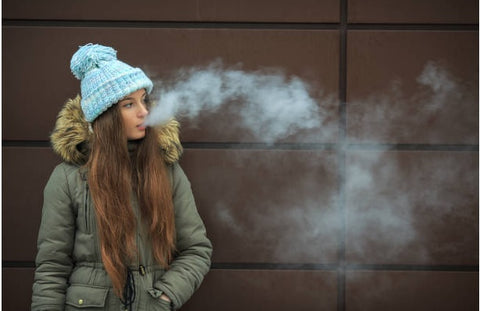
It’s a known that cigarette smoke is a significant public health risk, and harms the smoker and the people around them (via secondhand smoke).
And that's why many smokers are switching to safer alternatives like vapes.
But it begs the question — Can you get second hand smoke from a vape?
The short answer is yes, but there’s more to it than meets the eye.
Secondhand smoke from a vape has a different chemical composition from that of tobacco cigarettes.
However, prolonged exposure to second hand vapor could be as damaging to your body as second hand cigarette smoke!
Luckily, there are ways to minimize the risks — like using high-quality nicotine-free vapes.
Let’s explore everything you need to know about secondhand nicotine vape exposure, its potential health risks, and other second hand vape FAQs.
Read more:
|
This Article Contains:
- What is Second Hand Vape Aerosol?
- Is Second Hand Vapor Harmful? (Potential Health Risks)
- Second Hand Vapor VS Cigarette Smoke
- 3 Proven Ways to Minimize the Risks Of Secondhand Vapor
- Use High-Quality & Nicotine-Free Vape Products
- Vape in Well-Ventilated or Designated Smoking/Vaping Areas
- Avoid Vaping Around Children or High-Risk Groups
- Other FAQS About Second Hand Smoke From a Vape
Let’s get started!
What is Second Hand Vape Aerosol?
Secondhand aerosol is the vapor exhaled into the air by an e cigarette user.
Now, like second hand cigarette smoke, second hand vaping aerosol can linger in a room long enough to be inhaled by someone else (passive vaping).
What does e cigarette aerosol contain?
According to the American Lung Association, secondhand aerosol from low-quality electronic cigarettes and vapes may contain harmful chemicals, such as:
- Lead, nickel, tin, or other heavy metals
- Nicotine
- Benzene
- Diacetyl
- Formaldehyde
- Acrolein
- Ultrafine particles
- Acetaldehyde
- Isoprene
- N- Nitrosonornicotine
- Toluene
Prolonged secondhand exposure to these substances can cause nasty side effects and public health risks.
Is Second Hand Vapor Harmful? (Potential Health Risks)
Here’s the deal: Electronic cigarettes are still relatively new, and the long-term health effects of secondhand vaping are still under research.
But what do the existing studies say about second hand vape exposure?
You could inhale high levels of nicotine when exposed to secondhand vape smoke. In fact, the nicotine exposure levels via aerosols could be similar to that of secondhand cigarette smoke.
And we all know that nicotine is a highly addictive and harmful stimulant.
Here are some health risks of second hand nicotine aerosol exposure:
- Onset or worsening of conditions such as asthma and chronic lung disease. Long-term exposure can even result in children developing asthma.
- Eye, throat, and airway irritation
- Lung damage and inflammation
- “Popcorn lung”
- Cardiovascular toxicity
- Oxidative stress
- DNA fragmentation (the breaking of DNA)
But that's not all…
People with existing health conditions or weak immune systems are more likely to experience the adverse health effects of secondhand nicotine aerosol.
Who’s Most at Risk From Secondhand Nicotine Vape Exposure?
According to health care experts, the following groups are at high risk from second hand vaping exposure:
- Children, teenagers & young adults
- Pregnant woman
- People with respiratory symptoms from conditions like asthma, COPD, and bronchitis
- Elderly people
- Patients with heart conditions
Disclaimer: If you have respiratory symptoms or a heart condition and are concerned you’ve been exposed to second hand vaping, seek medical advice from a health professional.
Now:
These secondhand nicotine aerosol side effects may seem unnerving.
But there’s a silver lining.
Many of these risks are directly linked to substances like nicotine and diacetyl (commonly associated with tobacco use), which you can thankfully avoid.
And that’s not all.
Second hand smoke exposure from an electronic cigarette is much less harmful than passively inhaling tobacco smoke. Let’s find out how they differ.
Second Hand Vapor Vs Cigarette Smoke
Primarily, second hand vaping aerosol and cigarette smoke differ in how they’re produced:
- Cigarette smoke: Produced by burning tobacco and other additives in a cigarette or tobacco product.
- E cigarette aerosol: Produced by vaporizing the e-liquid containing nicotine, flavors, and other additives.
Now, studies show that burning a tobacco product and other chemicals in tobacco cigarettes exposes you and the people around you (via passive smoking) to many deadly carcinogens.
This risk is significantly lower with e cigarette use, where you do not inhale any burning fumes.
But here’s where it gets interesting.
A traditional cigarette contains roughly around 7000 chemicals compared to 2000 in vape juice. No wonder sidestream and mainstream smoke from a tobacco cigarette pose a more severe threat to bystanders than secondhand vape aerosols!
Note: The Centres for Disease Control and Prevention (CDC) states that secondhand exposure to cigarette smoke can cause severe diseases and even premature death among people who do not smoke. So, it’s no surprise that the American Lung Association found that secondhand cigarette smoke causes around 7,330 lung cancer deaths and 33,950 heart disease deaths annually.
Fortunately, Public Health England found that vaping could be up to 95% safer than first-hand tobacco use and cigarette smoking! It’s safe to say these statistics apply to secondhand vape aerosol as well.
Studies also show that aerosols from e cigarette use dissipate in the air much quicker than tobacco smoke aerosol. This greatly reduces the risk of secondhand smoke exposure from a vape pen.
In a nutshell: Second hand tobacco smoke contains much higher levels of cancer-causing compounds and is much more dangerous than electronic cigarette aerosol.
The good news?
Every e cigarette user can further minimize the risks associated with secondhand vape smoke by taking some vital measures.
3 Proven Ways to Minimize the Risks of Secondhand Vapor
Perhaps you’re an e cigarette user who wants to minimize the risk of secondhand vape exposure for others.
The first thing you must do: Check if there are any non-smokers nearby, especially high-risk groups, before using your vaping device.
Here are some helpful ways you can keep public health risks associated with e cigarette emissions to a minimum:
1. Use High-Quality & Nicotine-Free Vape Products
The most effective way to reduce exposure to harmful chemicals from passive smoking is to use high-quality, nicotine free vape products.
Where can I find a vaping device like this?
At Cyclone Pods, of course!
Cyclone Pods vapes are a safer alternative to traditional cigarette smoking and are free from harmful substances like:
- Nicotine
- Diacetyl
- Formaldehyde
- Vitamin E acetate
Looking to test out nicotine free vapes for yourself?
Try the Gust Super from Cyclone Pods. It comes in nine delicious flavors and packs in over 5000 puffs! Or opt for our newly launched Surge line — an eco-friendly choice that not only satisfies your taste buds but also supports sustainable living.

2. Vape in Well-Ventilated or Designated Smoking/Vaping Areas
Since vaping aerosol dissipates easily in the wind, exposure risk is lower when you vape outdoors.
If you’re vaping indoors, ensure you do so in a designated vaping or smoking section to avoid exposing others to harmful chemicals from your secondhand smoking.
3. Avoid Vaping Around Children or High-Risk Groups
As we mentioned earlier — it’s your responsibility to be mindful of when and where you vape. We encourage you to make an effort to avoid e cigarette smoking near children, young adults, or high-risk groups, and find an uncrowded area to take a puff, limiting secondhand vape exposure for others.
Now let’s answer some additional questions you may still have about second hand vape smoke.
Other FAQS About Second Hand Smoke From a Vape
Here are some other aspects of secondhand vape aerosol:
1. How Long do Vape Chemicals Stay in the Air?
The concentration of particles in secondhand aerosol from a vape dissipates in a matter of seconds. In comparison, secondhand cigarette smoke can linger for 30-45 minutes.
2. Can I Vape Inside My House?
You can use electronic cigarettes inside your house.
But remember — e cigarette emissions can damage air ducts, negatively impacting your home’s indoor air quality. And that’s nothing compared to what it may do to children, young adult members, and other high-risk groups in your house.
Did you know? According to a Tobacco Control Journal report, over 507.74 million children (in 21 countries surveyed) are exposed to secondhand smoke at home.
Safer Vaping For Everyone – Using Nicotine-Free Vapes
Passive vaping can put you at health risks similar to secondhand cigarette smoke in the long run.
Luckily, nicotine-free electronic cigarettes allow you to reduce the risks of second hand vape exposure to yourself and others.
Cyclone Pods makes vaping safer and more accessible with their tobacco and nicotine-free range. Head to the Cyclone Pods website to see how to transform your vaping experience.

